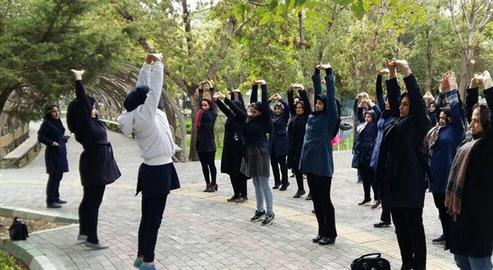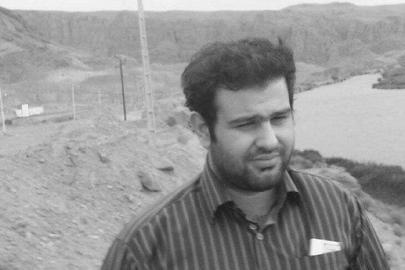More than 40 years have passed since mandatory veiling was imposed on women and girls in the Islamic Republic of Iran. Despite this, activists inside the country continue to rail against it, both in public and amongst themselves.
The notion that a handful of men ought to decide on the type of clothing worn by 40 million women has never seemed sensible. Today, the absurdity has reached a point whereby women who do not observe the hijab are fined by text message and hauled straight to the police station.
Apart from the obvious affront to their autonomy, and the draconian consequences of not following the law, misogynistic edicts on clothing are having an impact on Iranian women’s physical wellbeing. Incidences of osteoporosis due to a lack of vitamin D are on the rise, and have been linked to not enough sunlight reaching their bodies.
The issue is far from new. Back in 2003, physicians at Tehran University of Medical Sciences submitted a report to the governor of Tehran, warning about increasing numbers of women suffering from osteoporosis: a weakening of the bones that can lead to breakages, and in severe cases, to disability.
The report led to the government establishing a "women's only park" called Behesht-e Madaran (literally “Mother’s Paradise”), in May 2008. In this environment, it was hoped, women could frolic and have fun without having to wear hijab and away from prying male eyes. By the end of 2020, six more female-only public parks had been established in Tehran including Narges Park, the Shahrbanou Complex and Reyhaneh Park.
The proponents of these parks have generally been male government officials and agents of the regime. Meanwhile, prominent women’s rights activists in Iran, from Nasrin Sotoudeh to Narges Mohammadi, have strongly opposed their establishment, calling it "gender segregation and injustice against women, and a step toward the exclusion of women from society."
To try to gauge the view of ordinary Iranian women, I visited the original Behesht-e Madaran park in the run-up to the hot Iranian summer, and spoke to some of the regulars.
The first person who stopped to talk was a middle-aged woman named Narges, who attends Behesht-e Madaran along with her daughter – but isn’t happy about it. “Exercise without the hijab definitely feels good,” she said. “I’m not saying I want to be naked on the street, but why can’t I walk in the streets and ordinary parks in the same pants and T-shirt I’m wearing now?
“My daughter and I sometimes get really upset about the hijab in this heat. We have no choice but to take refuge in this park. But my daughter, who works, constantly complains about wearing the hijab. She doesn’t like it and wants to go abroad so that she can work, have fun, and live freely."
"My real dream is to be able to walk the streets like this," agrees Sarah, who is about 25. "I can’t understand the official position at all. Don’t they see women’s resistance and opposition to mandatory veiling? I want to be able to dress freely and as I choose.”
The next group I encountered in the park was a huddle of teenage girls, aged 16 to 19. Given their age, it was natural that they had a lot to say on the matter.
Perhaps bravely, Yeganeh told me she doesn’t wear hijab in the streets or public parks of Tehran either. None of the women in her family do, she says, and her father doesn’t object – and would back her corner were she to be arrested.
“Why should the type of dress I wear be important to strangers,” she says, “and why should they decide for me? Don't we own our own bodies?
“That said, my own body is constantly shaking on the subway and in the street, in fear that the morality police will arrest me. The insecurity we feel is, in fact, created by the government itself – not by men. Theytreat us very badly during detention; these same savage agents...”
Her friend Sarvenaz intervenes. "Yes, they are wild, and they go through everything you have on you. They take your phone and check through it. They humiliate you."
"If you actually commit a crime and then the police arrest you, it’s fair enough,” says teenage Aysan. “But the fact that you know you’re completely innocent, and are being punished and made to apologize just for wearing your favorite clothes, is really painful.
“I will leave Iran in a few years, God willing. But I feel really sorry for myself and my peers. When I see pictures of my grandmother's youth, I’m ashamed to call myself young now! If that was their youth, then what exactly are we doing now? What made them have a revolution?"
"Our dream,” says a fourth young woman, Melissa, “is to go out as a group in beautiful, comfortable clothes, and walk the streets and shopping malls, and wear a bikini on the beach. Are these big dreams?"
I didn’t know what to say to these frustrated teenagers. OIn retreating from the group, I met another middle-aged woman, Mehri, who had an only-slightly more nuanced view on the matter.
"Because of my religious beliefs,” she told me, “even if it were possible, I still wouldn’t like to go without a hijab. But the real question is, should it be mandatory? Where in Islam does it say that thousands of years later, governments ought to force women to wear headscarves and mantles?”
She adds: “I have two daughters, both of whom have chosen the hijab of their own free will. But both of them consider this choice to be the right of all women, and oppose mandatory veiling. In fact, compulsory hijab has made women hate it and turn their backs on religion. There’s no brains in the skulls of the officials and mullahs, apparently."
Tina, 30, is one of the Iranian women who have been negatively affected by the lack of sunlight Tehran University physicians warned about. She is in the park on a doctor’s orders, trying to take in some natural vitamin D.
"I have a vitamin D deficiency,” she says, “and so I walk about or sit in the sun in my more open clothes. My doctor says Iranian women are always deficient in vitamin D, that their hair falls out so much because they always wear a scarf.”
Finally I met with two young women in their mid-20s. Both were emphatic that they would go without the veil in mixed parks and in public, given the chance. One of them, Ayda, described it as a form of “torture” outside of the house: “We are completely free in our family home, and at parties and weddings there’s no sign of a hijab, but being outside is like psychological torture for me. I feel very sorry for myself and other women for having been born here.”
Her friend Sahra comes from a more conservative family, where headscarves are worn even inside the house, and has longed to emigrate since her teenage years so that she can be rid of the custom. The spiralling cost of dollars and Turkish lira is all that stands in the way.
“For now I come to this park,” she says, “so that the wind can blow in my hair for just a few hours, and so that the sun reaches my skin.” She laughs shyly: “I pretend to myself that I’m living somewhere else.”
This article was written by a citizen journalist in Tehran under a pseudonym.
Related coverage:
Presidential Hopeful's Sexist and Racist Comments Stun Even His Most Ardent Followers
Khamenei: Women in Animations Must Wear Hijab
Khamenei Dismisses Hijab Protesters as “Insignificant and Small”
People Want the Choice on Hijab — But the Regime Won't Listen
From Rejection to the Death Sentence: The Fate of Iranian Clerics who Oppose Forced Veiling
visit the accountability section
In this section of Iran Wire, you can contact the officials and launch your campaign for various problems



























comments